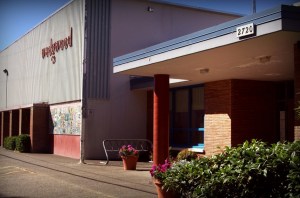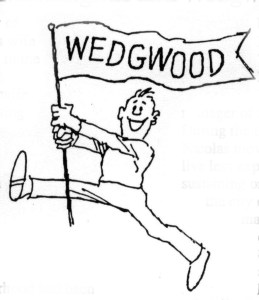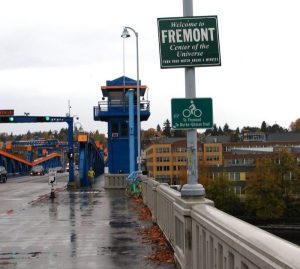In September 1991 when my daughter entered kindergarten at Wedgwood School, it was a déjà vu moment for me because she was walking into the same classroom where I had attended in my own kindergarten year at Wedgwood School.
As I participated in the Wedgwood School PTA, I drew upon my background of having grown up in the Wedgwood neighborhood in northeast Seattle. The PTA projects of that 1991-1992 school year led to the local history writings which I have continued to do up to the present day.
Drawing upon my roots in Wedgwood

In 1992 retired businessmen Grant McVicar and Russ Evans came to school to tell students about their experiences in the neighborhood.
As a Wedgwood PTA mom in the 1991-1992 school year, I (Valarie) got involved in a project to bring local history into the classrooms.
For the local-history emphasis, students at Wedgwood School wrote about their own family backgrounds and how they came to live in Wedgwood.
Students interviewed longtime local residents and asked questions about life in the neighborhood in the 1950s and 1960s. Students learned the names of businesses in the neighborhood in earlier years and were introduced to Wedgwood businessmen and community activists who came in to speak in the classrooms. Along with other PTA moms, I went out into the community to talk to long-time residents. Some, such as retired businessmen Grant McVicar (hardware store) and Russ Evans (grocery) were willing to come in to school to be interviewed by students.
Some long-time neighborhood residents, visited at their homes, told stories of early days which we recorded or wrote up, to tell to the students. It was in these contacts with Wedgwood neighbors (some of them more than ninety years of age) that I learned stories of Mr. Thorpe the ginseng farmer and his log house which became the Chapel of St. Ignatius. The five-block square property then became the site of the original Wedgwood development of houses by Albert Balch.
Writing for the community newsletter

Mr. Thorpe, the ginseng farmer, as depicted in a cartoon by Bob Cram for the Wedgwood Community Council newsletter of May 1995.
Dorothy Brancato, then-editor of the Wedgwood Community Council newsletter, heard about our school project and wanted me to write articles about the history of the neighborhood, to be published in the newsletter.
With Dorothy’s gentle coaxing and encouragement, I began to write, and my first article in the paper newsletter of the Wedgwood Community Council appeared in the May 1992 edition. In that era before the use of photos in the newsletter, Dorothy arranged for each of my articles to be illustrated with a cartoon by Wedgwood resident Bob Cram.
In the 1990s I also did a local-history project for Meadowbrook, the next neighborhood to the north of Wedgwood. The collection of photos and Meadowbrook history articles was commissioned for the new Meadowbrook Community Center building, 10517 35th Ave NE, which opened in January 1997. The history book is in a display stand in the lobby of the building. Most of the Meadowbrook history articles in that display book are now posted here on this blog, as well.
Launching a blog in 2012
In 2012 I was still writing for the Wedgwood community newsletter when the decision was made to end the paper newsletters and transition to all-on-line website and social-media. At that time I started Wedgwood in Seattle History as my personal blog for Wedgwood history articles. I began by updating and reformatting some of my previously-written neighborhood history articles which had been published in the paper newsletters from 1992 to 2012, and I posted those articles on this blog.
Since 2012 I have continued to do more research and writing about the Wedgwood neighborhood. Then I took the Meadowbrook material which I had written in the 1990s and posted those articles here on this blog, too. That was the beginning of expanding Wedgwood in Seattle History to include articles about other neighborhoods of northeast Seattle.
Expanding this blog to include other northeast Seattle neighborhood history
According to the page-view statistics for this blog, some of the most frequent subject inquiries on Wedgwood in Seattle History are for information about Wedgwood Rock (I have written six articles about the Rock) and about how and when Wedgwood became part of the City of Seattle.

The golf course at the Sand Point Country Club has views to the northeast toward Lake Washington. Searches for info about the golf course are among the most-frequent inquiries on this blog.
It is interesting to note that this blog also has high page-view statistics for articles about the origins of other neighborhoods in northeast Seattle, such as Hawthorne Hills, Inverness, Laurelhurst, LaVilla, Matthews Beach, Pontiac, Ravenna, the Sand Point Country Club and Golf Course, and the old village of Yesler.
Other often-viewed articles on this blog are about the origins of the Picardo Farm P-Patch, the Burke-Gilman Trail and about the Thornton Creek watershed.
Categories on this blog are listed on the tab on the right margin. Another category I have added, is that of plat names. A plat is an area of land, any size, for which a map of lots is done. There are many examples of plat names which became the name of the neighborhood, such as Wedgwood. The plat filer, Albert Balch, did not intentionally name the neighborhood, but the name spread in popular use from his first cluster of houses.
The number-one most-read article on Wedgwood in Seattle History is a general outline of how the City of Seattle was founded, with an explanation of Seattle’s downtown street names. I have also written an article about street names outside of downtown Seattle, as to how the streets were named.

The Fremont neighborhood in Seattle is located at the northwest corner of Lake Union. Map courtesy of HistoryLink.
The next thing that happened over the years since starting this blog in 2012, is that I began writing about the history of the Fremont neighborhood of Seattle. Fremont’s history is in great contrast to that of Wedgwood. Considering the differences has helped me understand the impact of historical events and even geography itself, as some neighborhoods developed more quickly if they had more “convenient” topography.
Seattle grows out into Fremont in 1888
The Fremont neighborhood is located at the northwest corner of Lake Union, about four miles straight north of downtown Seattle. It was the 1854 homestead claim of William A. Strickler , but was not developed at that time. Strickler disappeared in 1861 and due to the long-running legal problems about the ownership of Strickler’s land claim, no one lived on the property until after the case was resolved in 1887.
The neighborhood was named by investors Edward and Carrie Blewett who came out from Fremont, Nebraska, in 1888. Mr. and Mrs. Blewett only came to invest and not to stay. They left the development of Fremont in the hands of their real estate partners in Seattle.

Fremont in Seattle has a vibrant business district with scenic views along the ship canal and the Burke-Gilman Trail. This photo was taken while standing on the Fremont Bridge, viewing the Aurora Bridge to the northeast.
In 1888-1889 Fremont began to be populated with its first homes and businesses. Industries which were established in Fremont’s first year of existence included a lumber mill, a construction materials company and an iron foundry. It was fortuitous timing.
Less than one year after the establishment of residences and industries in Fremont, a major fire on June 6, 1889, destroyed most of Seattle’s downtown commercial core. The industries of Fremont were up and running by that time and were ready to produce materials for rebuilding the city. Fremont thrived with businesses and rapidly-increasing residential development as the population of Seattle boomed after the Fire.
The Great Fire of June 6, 1889 in downtown Seattle caused industries and residential development to be pushed out to the edges of what was then the settled areas of the city. After the Fire in downtown, Fremont exploded with even more residential housing, and its industries grew and prospered.
Fremont’s active citizens sought the benefits of city services and so, Fremont was absorbed into the City of Seattle boundaries in 1891. In the 1890s Fremont activists served on Seattle City Council and they promoted the proposed route of a ship canal which would go past Fremont and enhance the business environment. The legacy of activism still characterizes the Fremont neighborhood of today.
Writing from Wedgwood and beyond
My personal writing journey began in my growing-up years of the 1950s and 1960s when I listened to elderly relatives tell stories of their lives. In the sixth grade in the 1963-1964 school year, my teacher encouraged me to write down these stories. During that school year we lived through the assassination of President John F. Kennedy and I began to understand how seemingly far-away events could affect us on a personal level.
That was the beginning of my interest in setting life stories within the context of historical events. That is why, when I chose a name for this blog, I called it Wedgwood in Seattle History.
The need to know the background of the history of our city, has caused me to continue to do research and expand my understanding of historic events. “Wedgwood in Seattle History” can be abbreviated WISH which expresses my wish to convey the fascinating history of Seattle.
Social, cultural, geographic and economic forces set the stage for why the City of Seattle developed as it did, and why and how Seattle neighborhoods differ from one another. The story of the Fremont neighborhood is in great contrast with Wedgwood and it helps to explain the different factors which shaped the growth of Seattle. In the past few years as I have written articles about the history of Fremont in Seattle, I simply added a Fremont category here on this Wedgwood blog.
Blogging onward
My Wedgwood neighborhood history writing has progressed from the first community newsletter articles which I wrote on a typewriter in 1992, to today’s convenient on-line blog format. One of the best aspects of blogging is being able to share widely with anyone who is interested in the subject of Seattle history. I follow several other Seattle blogs here on WordPress, and I greatly enjoy all the photos and perspectives of other blog writers.
I have found a number of connections to the stories of Civil War veterans from other states who eventually migrated out to Seattle, so I have added Civil War as a category on my blog.
I want to thank all of my blog readers who have followed Wedgwood in Seattle History since 2012. I hope you will continue to follow the adventures in Seattle history here on my blog.

The Fourth of July, 2017, was the hundredth birthday of the Fremont Bridge. The Waiting for the Interurban statue was decorated for the occasion. The statue is at the corner of Fremont Avenue and North 34th Street, just north of the Fremont Bridge. The “Interurban” was a train line which once ran from Pioneer Square in Seattle to Everett.





Wow, 2012 was right about when I decided to live in Seattle (after a three-year adventure on the road writing for other sources, a crazy story for another day). Writing is a most wonderful thing for the soul, especially when it’s focused on something you love, and can share. Love your writing with all the great information added. I will keep much of what you shared in mind when exploring the areas you covered, and I shall continue to follow!
Thank you, Orion!
Great article and blog. Am learning a ton about the old neighborhood. I grew up in the “Devries” house from roughly 1966-1978.
What’s interesting is that you never saw the side of the house that is pictured in the blog due to the large rhododendrons planted around the east side.
Good observation, Sam! The DeVries house at 3000 NE 85th Street is not very visible in its present location. That is why I chose to use an earlier photo of the house before it was moved there, to show what it originally looked like. Of course the house has been modified, too, so it does not look the same. The photo is in the article “The Beginnings of Wedgwood School.”
Having been born and raised up the I-5 in Vancouver, BC, Dad loved road-trips and one of his favourites was by proximity to Bellingham, WA, and less frequently, to Seattle. It is with a boy’s eyes that I saw Dad love driving and what that access meant to new places and new things. I’ve always had a big place in my heart for history and for Seattle: I look forward to reading your blogsite.
I glad you are enjoying the stories!